In the ever-evolving landscape of catering trends, one culinary delight has resurfaced with a newfound popularity: pies. These humble and comforting treats, once relegated to family dinners and cozy bakeries, are now making a grand entrance at catered events. From weddings and corporate functions to social gatherings and holiday parties, pies are capturing the hearts and taste buds of guests everywhere.
“Our palates crave an array of different things, from sweet and salty, to fruity and crunchy or even smooth and custardy," says Deanna Johnson, Executive Pastry Chef for Bold Catering & Design. “People want things that are familiar to them but presented to them in such a way to create an experience.”
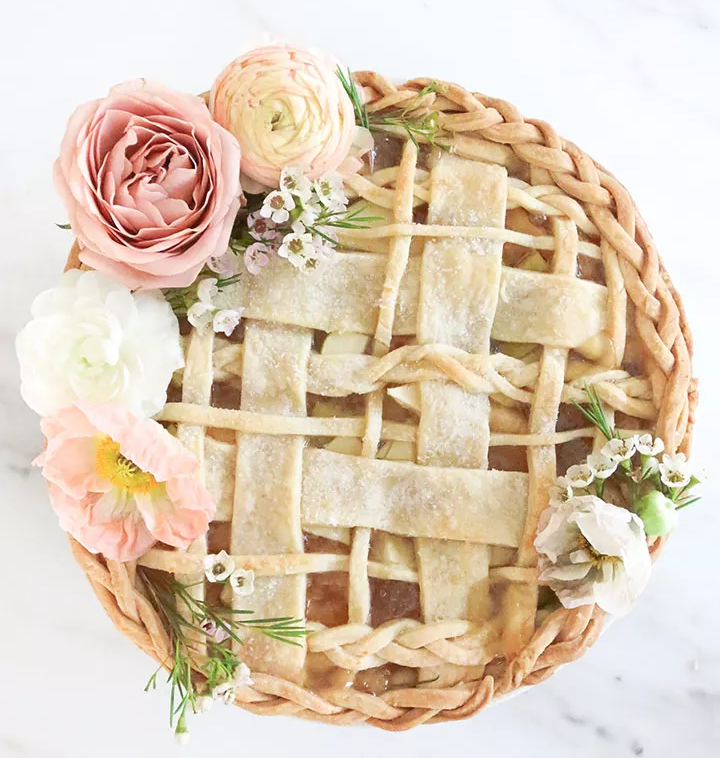
A formal wedding pie. Photo courtesy Mon Cheri/Monika Hibbs for Southern Living
Let’s take a look at this sweet (and sometimes savory) trend and how it is getting its own slice of the catering business.
Getting a piece of the pie
Before we get into the pie trend, we can’t flake on recognizing its origins. According to Food & Drink Resources, ancient Greeks and Romans were the first to make pie. The crust was simple, and it usually contained meat or other savory fillings. Pilgrims then brought Englishstyle “pye” recipes with them to the colonies. Pies were practical because the crusts preserved the fillings and kept them fresh during the winter months.
“For all of time people have taken ingredients native to their lands, created a dough, filled it with something hearty and delicious and baked them in the oven,” says Johnson.

Warm Potato Tart with Arugula, Figs, Prosciutto, and Truffle Vinaigrette (goat cheese, Idaho potato puree, fig and Vidalia onion marmalade, arugula, truffle vinaigrette, prosciutto, and figs). Photo courtesy Idaho Potato Commission
Today pie has emerged as the third most common dessert on menus, after cakes and cheesecakes, according to Datassential’s Dessert Keynote report. In fact, a whopping 78% of consumers indicated that they love or like pie, according to the report.
What’s causing the rise in pie’s popularity?
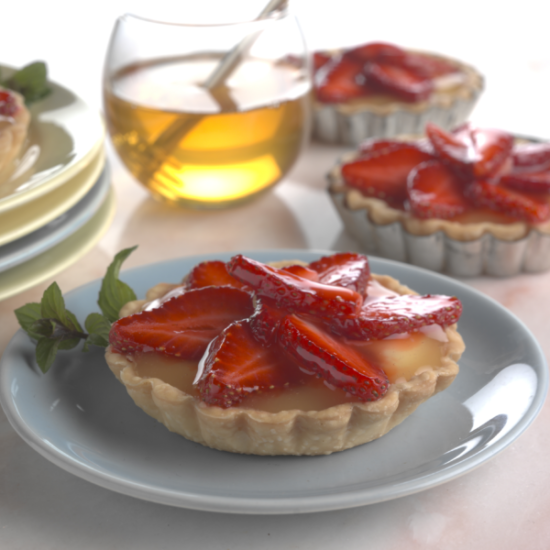
Honey Glazed Strawberry Tart (honey, apricot nectar, lemon juice, cream cheese, almond extract, strawberries, mint, and orange peel). Photo courtesy National Honey Board
For starters, pies tap into the nostalgia and comfort trend that has gripped customers’ attention for the past couple years. Consumers crave the familiar, the dishes that bring them back to simpler times. Think: holiday traditions such as enjoying a piece of pumpkin or apple pie during Thanksgiving.
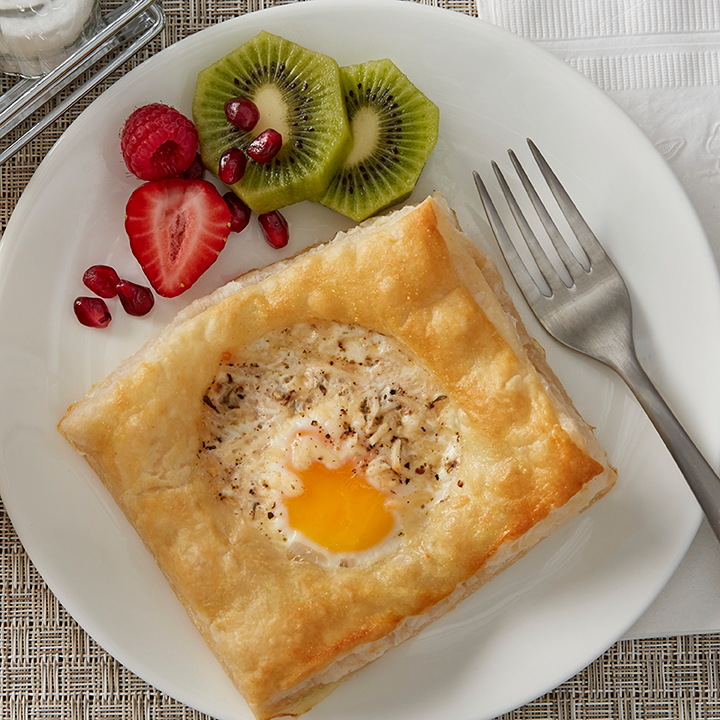
Italian Egg Tart (puff pastry crust, eggs, parmesan cheese, and Italian seasoning). Photo courtesy General Mills Foodservice
Probably the biggest contributor to pie’s popularity stems from its versatility since there’s no shortage of ways to approach this flaky favorite. Pie is nothing more than a crust with filling, which means it's a culinary blank canvas.
“Because pies are constantly pushing the boundaries of what both savory and sweet foods can be, it has become easier and more exciting for event chefs to create and play with their food,” says Bryce Cherven, Executive Pastry Chef for Footers Catering. “A lot of clients who host events regularly don't want to see the same thing every time, which challenges us as chefs to create new and exciting items that the competition isn't going to propose.”
Any way you slice it
Whether they’re baked, fried, sweet, savory, extravagant, or simple, pies can check a lot of different boxes for consumer tastes. Let’s take a look at pie’s versatility.
Sweet versus savory
Obviously, pie’s sweet spot is at the end of the meal as a satisfying dessert.
“Almost everyone has a sweet tooth, the moment where your taste buds start talking to you and your mouth waters and that tiny voice in your head says, ‘I want something sweet,’” says Johnson. “People want to be wowed, they want to create memories that will last a lifetime for their guests and make their event the talk of the town. What better way to do it than with the last thing they’ll have before they leave your event: dessert?”
Check out this completely delicious guide to popular types of pie.
“There are such a vast number of pastries, both savory and sweet, as per definition that would be included under the ‘pie or tart’ umbrella,” says Deanna Johnson, Executive Pastry Chef for Bold Catering & Design.
Double-crust
This type of pie refers to any type of sweet or savory pie that has both top and bottom crusts.
Examples: Chicken pot pie, fruit pies, etc.
Fruit
Any type of pie filled with fruit. Typically, a fruit pie has a fruit filling cooked in between two crusts, one on bottom and one on top, though the top crust could be replaced with streusel.
Examples: apple, berries, peach, etc. (based on the produce that’s in season)
Hand pies
A hand pie is just as it sounds, a pie made the perfect size for you to hold in your hand.
Examples: fruit, pierogi, empanadas, etc.
Chiffon
A chiffon pie is usually made with gelatin and requires refrigeration. The Jello-like filling is very light and a popular type of pie for summer.
Examples: lemon, strawberry, pumpkin, etc.
Cream
What distinguishes cream pie from a custard or chiffon pie is that it contains a pudding filling made predominantly with whipped cream and egg yolks. Generally, the filling is not cooked, but rather sets up in the fridge for at least four hours until it has solidified.
Examples: coconut cream pie, chocolate pudding pie, lemon cream pie, etc.
Custard
The difference between a custard pie and a cream pie is the proportion of cream and egg yolks. A custard pie will have a firmer filling and will require baking. The custard filling is mixed until super smooth before it’s poured into a pre-baked pie crust and finished in the oven.
Examples: pumpkin pie, sweet potato pie, etc.
Galette
A galette is a free-form pie that is made not in a pie dish but on a sheet tray. One single layer of pie dough is rolled out into a large circle. There’s usually a one to two-inch border of pie crust that is then folded over on the filling and the whole pie is baked in the oven until bubbling.
Examples: fruit (blueberry, apple, etc.), Galette Breton, Galette de Rois, etc.
Crostata
A crostata is an open-faced, freeform pie where a prepared fruit filling is placed over the top of raw pie dough, the edges folded over with the filling exposed. It is then egg washed and baked.
Examples: apricot jam, strawberry jam, onion, etc.
Tart
Unlike a pie, which is made with a pie crust, tarts are usually made with a buttery short crust (think: shortbread). The difference is that a traditional pie crust will always experience some shrinkage as it bakes, but a short crust will maintain its form, which is essential for delicate tarts.
Examples: fresh fruits, custards, eggs, or meats, etc.
Savory
Savory pies are non-sweet, “salty rather than sweet” pies served as meals or snacks, rather than as a dessert.
Examples: fish pies, pasties, pot pies, meat pies, shepherd's pies, cottage pie, beef wellington, spanakopita, quiche, etc.
Information above courtesy Food52
On the other hand, savory pies offer a tantalizing twist, bringing a touch of culinary adventure to catered events. These include chicken pot pies, shepherd’s pies, and empanadas, to name just a few.
“Wikipedia’s definition of the word pie is as follows: ‘A baked dish which is usually made of a pastry dough casing that contains a filling of various sweet or savory ingredients.’ Think of how many foods that really includes technically, even down to breakfast,” says Johnson. “You’ve got quiches, turnovers, and even toaster strudels, whole pies, and hand pies. From cultures all around the world, you’ve got Spanish empanadas, European pierogies, Italian calzones, Chicago deep dish, and Jamaican beef patties.”
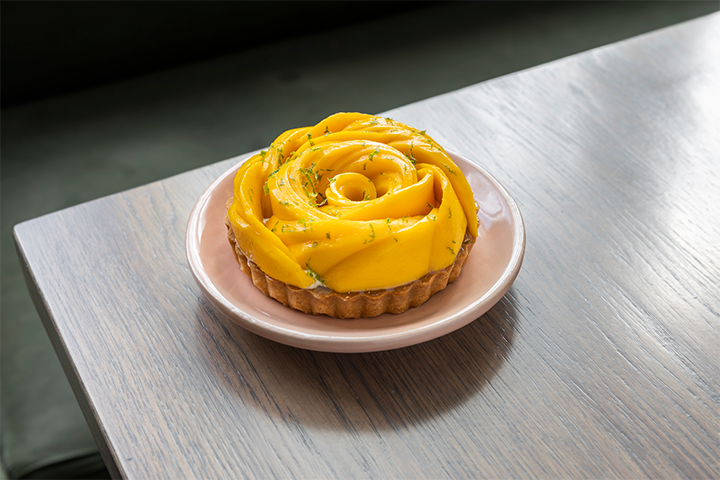
Mango Tart (coconut cream, brown sugar, vanilla, toasted coconut, mango, simple syrup, and lime zest). Photo courtesy National Mango Board
Whether they’re baked, fried, sweet, savory, extravagant, or simple, pies can check a lot of different boxes for consumer tastes. Let’s take a look at pie’s versatility.
The addition of savory pies to the catering menu provides a delightful balance to the sweet offerings and caters to the diverse preferences of guests.
“Savory pies and tarts are the best way to intermingle sweet and savory departments in the kitchen,” says Cherven.
Service styles
When thinking about how to serve pie during events, the sky’s the limit. Individual bite-sized options, pies stacked to look like a wedding cake, pies on a stick, pie bars, and even in cookie or cocktail form—all different ways of serving pie have their proper place.
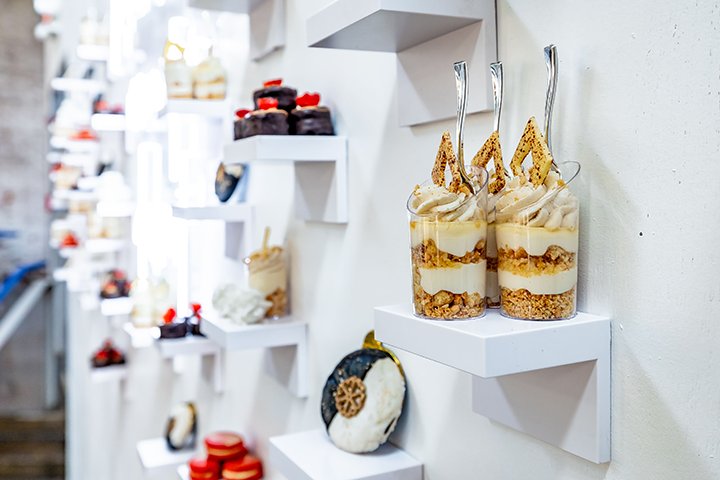
Bold Catering & Design offers an Eat & Greet dessert station. Photo courtesy Deanna Johnson
“Individual-sized desserts are admittedly more work on your team, but they provide a much bigger variety to the client. Being able to sample a few small bites and not commit to a whole slice of pie at the end of an already large meal will really appeal to the guests,” Cherven says. “Full-sized pies and things like pie bars, where the selection is a little smaller, can be great for the client that may have a hard time making decisions.
“These larger format desserts also open an incredible window of opportunity to turn each slice into a chef-attended short plate. Rather than having someone place a slice on a plate and let the guests self-serve toppings, turn it into an experience where the slice is drizzled with strawberry rose coulis, a dollop of fresh meringue, and then torched in front of the guest. They will remember the experience you created in front of them as well as being able to enjoy a curated small dish.”
Elevate it
Pies can be equally at home in formal settings as they are at a simple family gathering, where they can be plated and garnished with finesse. With beautiful golden crusts, intricate lattice designs, and vibrant fruit fillings, pies become edible works of art.
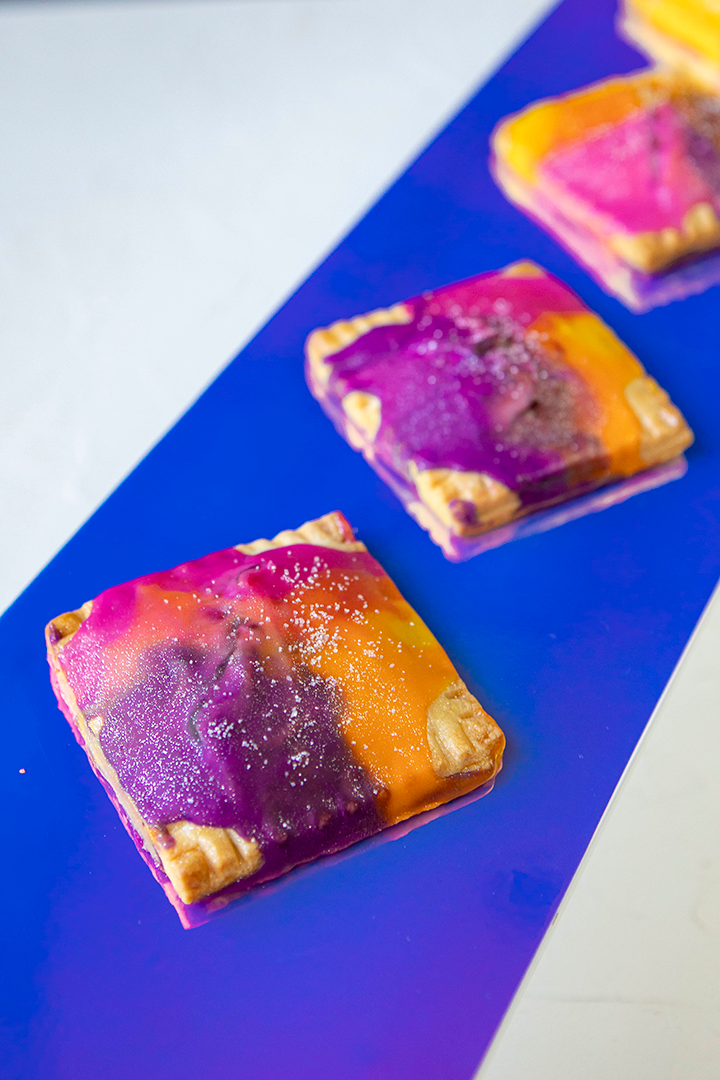
House-made pop tarts from 24 Carrots Catering and Events for their META’s Reel Night Out event. Photo courtesy Jackie Culmer
“To elevate any dessert, you must reconfigure what it is visually in your mind,” Johnson says. “Food is art, so you must be able to take any number of raw ingredients and transform them into a completely different creation. Tell the audience a story.
“Change the shape, add texture, layer flavors, change the consumers’ ideas of what the dish should be, what they’re used to. Show them what it could be when you use your imagination.”
Take me to flavor town
One of pie’s greatest assets is the fact that it can be a showcase for seasonal ingredients and regional tastes.
“I break my desserts down the way a savory chef might think about an entrée,” says Cherven. “Where you might have a starch, protein, and vegetable; I have a base, filling, and a top.
“Think about how it's going to be eaten, and work backward from there. If it's a one-bite mini tart, the filling will want to be big and flavorful. Conversely, a large slice doesn't need to have as big of a flavor impact; it can be more subtle and nuanced and build as the guest eats it.”
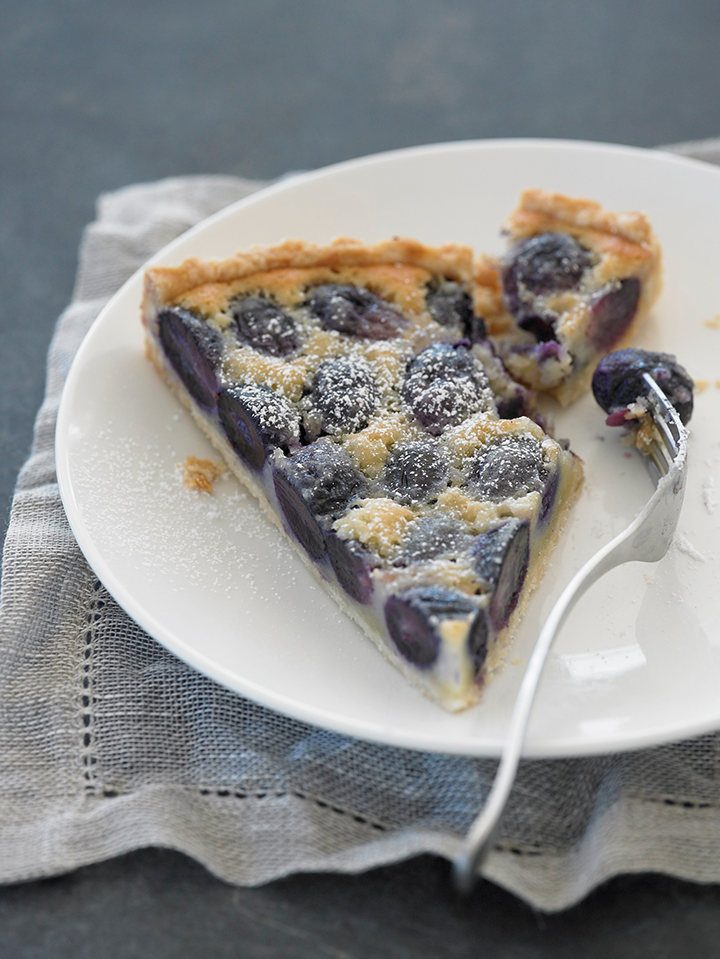
Grape Frangipane Tart (red or black seedless grapes and almond paste). Photo courtesy California Table Grape Commission
Pie can transport people to places they’ve been and places they want to be, according to Food & Drink Resources. From Greek Spanakopita and Moroccan Bisteeya to Florida Key Lime pie and Pennsylvania Shoofly pie, this pastry provides an authentic taste of a place that people are looking for today.
“If there’s one thing I’ve come to learn in this industry, it is that locals really appreciate homegrown products, something to be proud of,” says Johnson.
Something as small as changing the crust or tweaking the garnish can make a big impact on overall flavor and presentation, Cherven adds.
It comes down to the crust
One of the most important parts of any pie is the crust, which also brings a lot of versatility to the table.
“I tend to categorize pies by what the ‘crust’ is,” Cherven says. “Sometimes a ‘crust’ is an oat crumble, and sometimes it’s a batter, and sometimes it's a biscuit!”
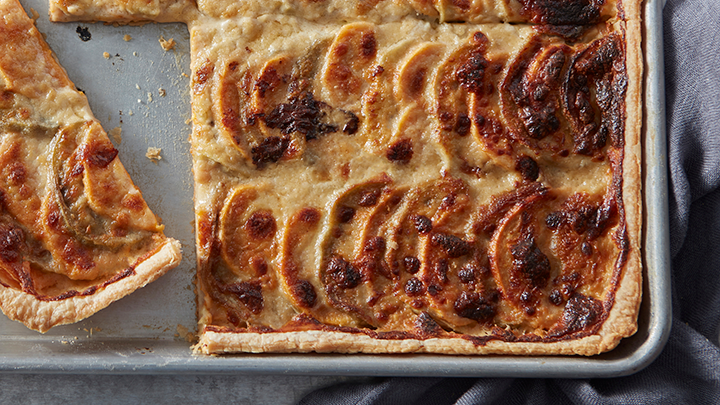
Sweet Potato Fondue Tart (puff pastry crust, white wine, heavy whipping cream, Emmental cheese, Brie de France cheese, maple syrup, cardamom, cinnamon, eggplant, and sweet potatoes). Photo courtesy General Mills Foodservice
There’s something to be said for making the crust inhouse as a way to experiment and create something truly unique, but pre-made shells also offer a great solution to ensure ease and won’t put as much time constraints on the kitchen staff.
Customization is key
Lastly, pies offer a wonderful opportunity for customization. It doesn’t take many adjustments for a pie to be vegan, sugar-free, dairy-free, gluten-free, and so on. This adaptability makes pies an ideal choice for events where guests have diverse tastes and dietary needs. By offering a range of fillings, crust variations, and sizes, caterers can ensure that every guest finds a pie that suits their palate.
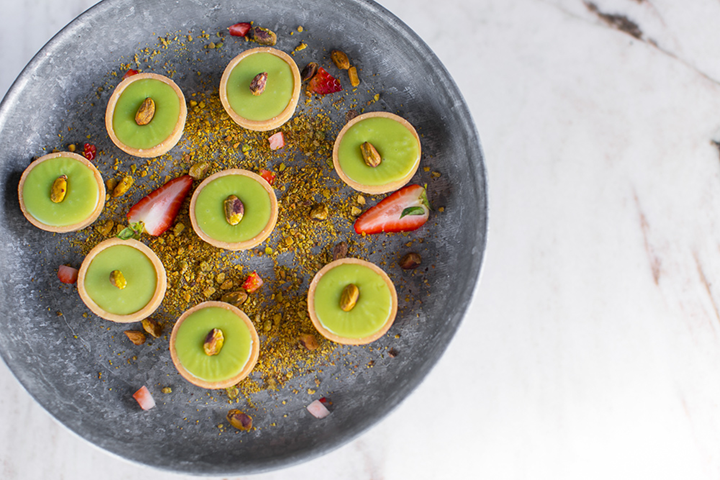
Bold Catering & Design’s Strawberry Pistachio Tart. Photo courtesy Deanna Johnson
Go to your local farmer’s market and see what’s in season or partner with local purveyors to get access to the freshest ingredients.
“When presented with the opportunity to utilize fresh seasonal ingredients, take advantage,” says Johnson. “Pair with complementary flavors that will highlight the main ingredient, not mask it.”
Now it’s your turn to slice off a piece of this tasty trend.
“The flavor landscape of pie becomes a playground for creativity,” says Sebastien Centner, Creative Director and Founder for Eatertainment Events & Catering. “Our team of expert chefs relish the chance to push the boundaries and present guests with an unforgettable experience, where each bite is a delightful adventure into uncharted taste territories. Embracing these trends allows us to craft delectable treats that captivate the senses and leave a lasting impression on every event attendee.”
Bon Appetit!
The first step in creating a delicious pie is fi nding the right crust recipe.
“I think of the dough recipes as the foundation of any good pie or tart,” says Bryce Cherven, Executive Pastry Chef for Footers Catering. “Find one great pie dough recipe and one great tart shell recipe and keep them forever. It's easier to make small changes on a great recipe than to re-build it completely.”
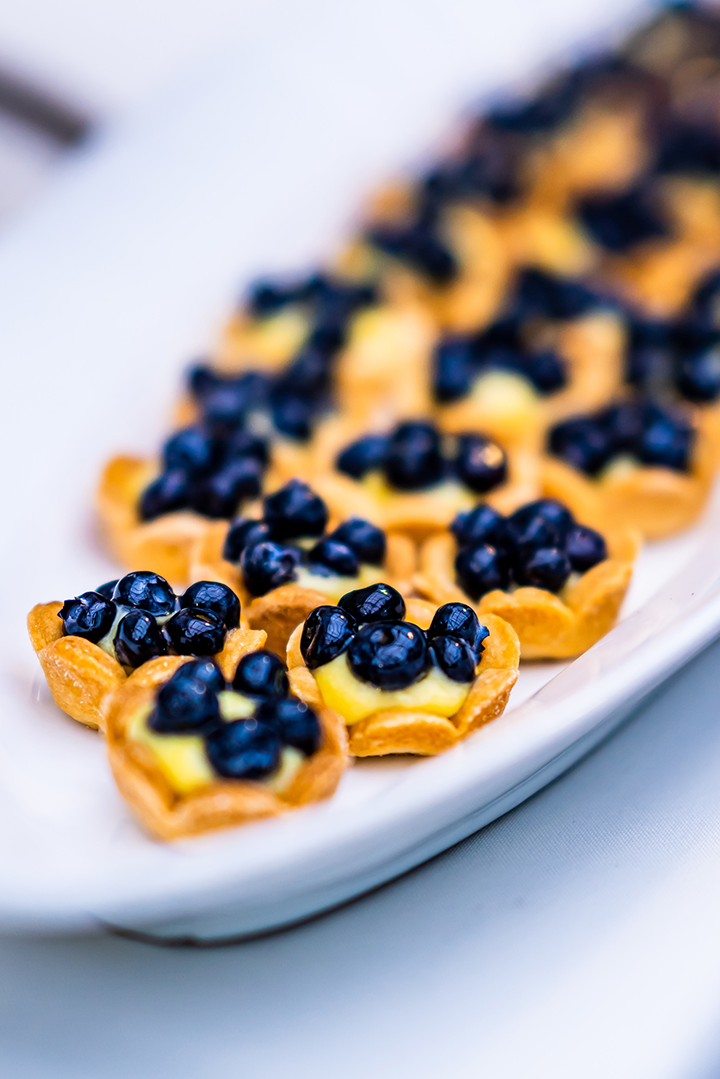
Sablee
Yield: 5 lbs
Recipe courtesy Bryce Cherven, Footers Catering
Ingredients
Method
- Using a paddle, cream the butter and sugar well.
- Add eggs, scraping well. Add salt, flour, and nuts if using.
- Add liquid last. Combine well. Chill before baking. If not using nuts add flour by half weight.
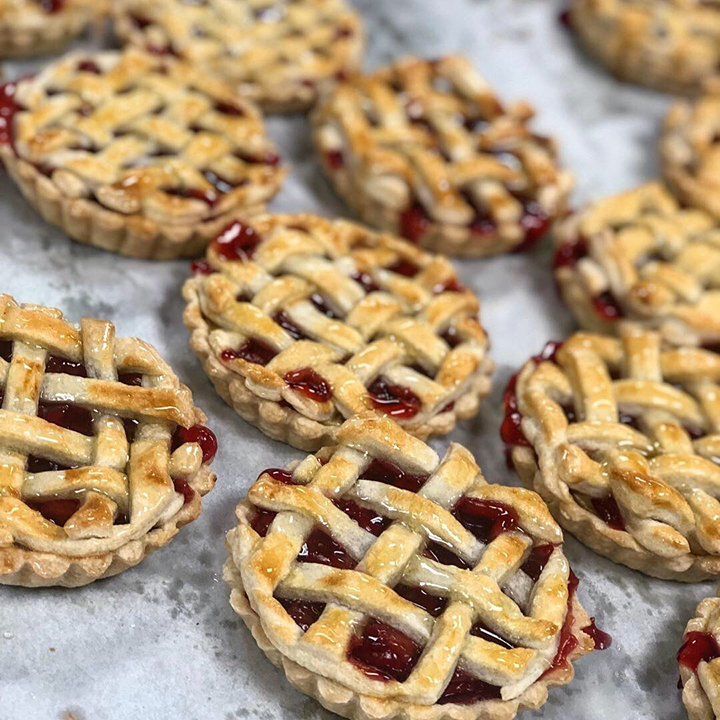
Pie Dough
Yield: 5 ½ lbs (approximately six 9-inch pie shells)
Recipe courtesy Bryce Cherven, Footers Catering
Ingredients
Method
- Combine all dry ingredients in the mixer with a paddle attachment.
- Add butter and shortening, allowing to mix until fats are smaller than pea-sized, being careful not to overmix.
- Add water slowly until dough is combined—you might not need all of it. Portion to 1 lb disks and chill.
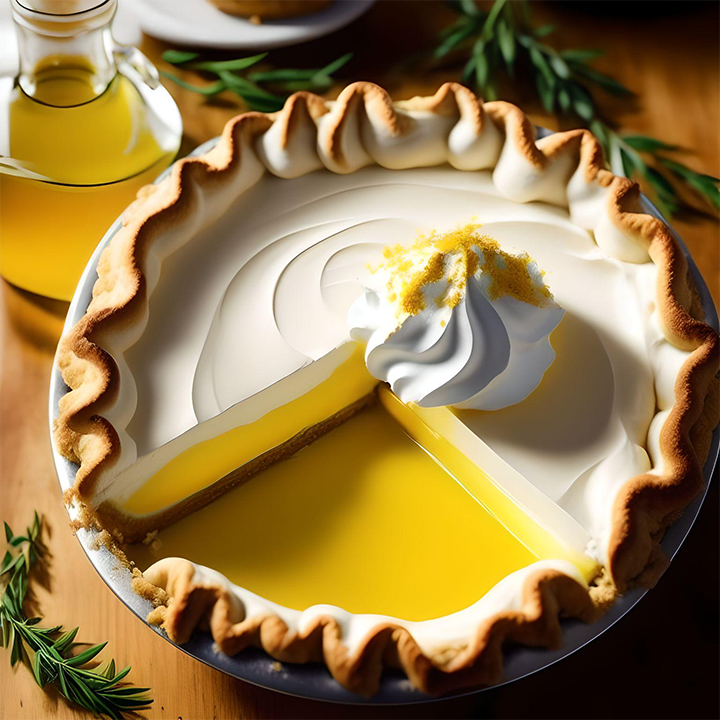
Meyer Lemon Olive Oil Meringue Pie with Herbes de Provence Crust
YIELD: 1
Recipe courtesy Bryce Cherven, Footers Catering
Ingredients for Pie Crust
Method
- In a mixing bowl with a paddle attachment, combine all dry ingredients.
- Add butter and shortening, allowing to mix until the fats are smaller than pea-sized. Add cold water slowly until the dough is combined—you might not need all of it!
- Chill before rolling out. Once rolled out, freeze before par-baking in a 350°F oven for approximately 15 minutes.
Ingredients for Filling
Method
- Combine all ingredients.
- Pour over the pie shell and bake at 300°F for approximately 20 minutes or until the center has a fi rm jiggle.
- Remove and allow to cool completely before decorating.
Ingredients for Meringue Topping
Method
- Place egg whites in a mixing bowl with a whisk attachment. Start on low to allow egg whites to “foam” while cooking sugar mixture.
- Combine sugar and water in a sauce pot until a candy thermometer reads 225°F.
- Turn your mixer up to get egg whites to soft peaks.
- Once your sugar mixture has reached 240°F, remove it from the heat and slowly stream it into the egg whites while they are continuing to whip on a medium-low speed. Whip your egg white and sugar mixture until the meringue is shiny and stiff peaks form.
- Add vanilla bean paste, mix until it’s distributed throughout, then turn your mixer off.
- To decorate your pie, you can either pile the meringue directly onto the pie and manipulate with a spoon or offset spatula or place the meringue in a piping bag with a piping tip and pipe rosettes or another border around the edge.
- Optional fi nal step: Garnish the meringue with fresh lemon zest.
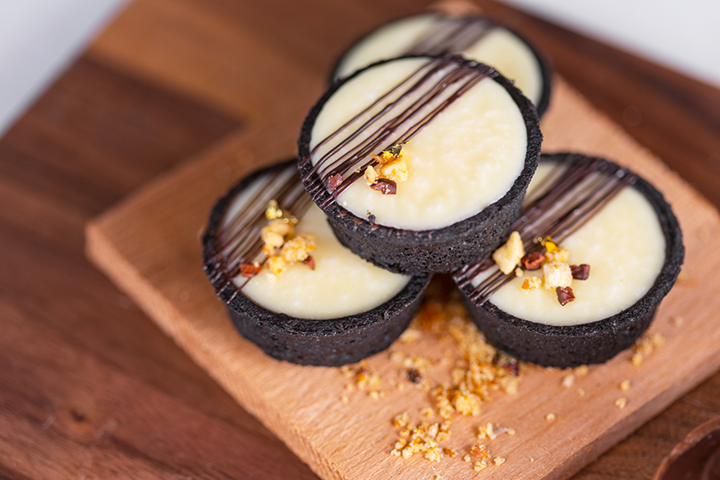
Irish Slammer Tart
Recipe and image courtesy Deanna Johnson, Bold Catering & Design
Ingredients
To Assemble
- In the bottom of each tart shell add 1 teaspoon pretzel crumb.
- Pipe salted caramel filling halfway up tart shell, freeze.
- Once caramel layer is frozen, top with freshly made Irish crème ganache.
- Garnish as desired. Suggested: drizzle with dark coating chocolate about of the corner and sprinkle with pretzel crumb and gold leaf.
Ingredients for Salted Caramel Filling
Method
- Pour water, sugar, and corn syrup in a heavy bottom saucepan, be sure to select a pan with at least four to five inches of additional height over the fill point, as when adding the cream the mixture will bubble heavily. DO NOT STIR. Boil to an amber in color, approx. 248°F
- In a separate pot, heat cream with salt until dissolved.
- Remove caramel from heat, add in heated cream mixture, slowly, as caramel will bubble vigorously. BE CAREFUL.
- Stir in butter and crème fraiche. Note: Test a drop on the table to see how it sets once cooled, continue cooking finished caramel to thicken if needed depending on the consistency you’re looking for. Alternatively, add cream to thin if needed for sauces, etc.
Ingredients for Bailey's Ganache
Method
- Pour white chocolate in a stainless-steel bowl over double boiler, melt slightly.
- In a medium bottom saucepan, heat Bailey’s and heavy cream, pour over partially melted white chocolate.
- Allow to set, covered for approximately two minutes to ensure white chocolate is melted. Whisk to combine.
Ingredients for Pretzel Crumb
Method
- Preheat oven to 350°F
- Combine all ingredients except cocoa nibs in a stainless-steel bowl, toast for three to four minutes or until golden brown. Once mixture cools, add in cocoa nibs.
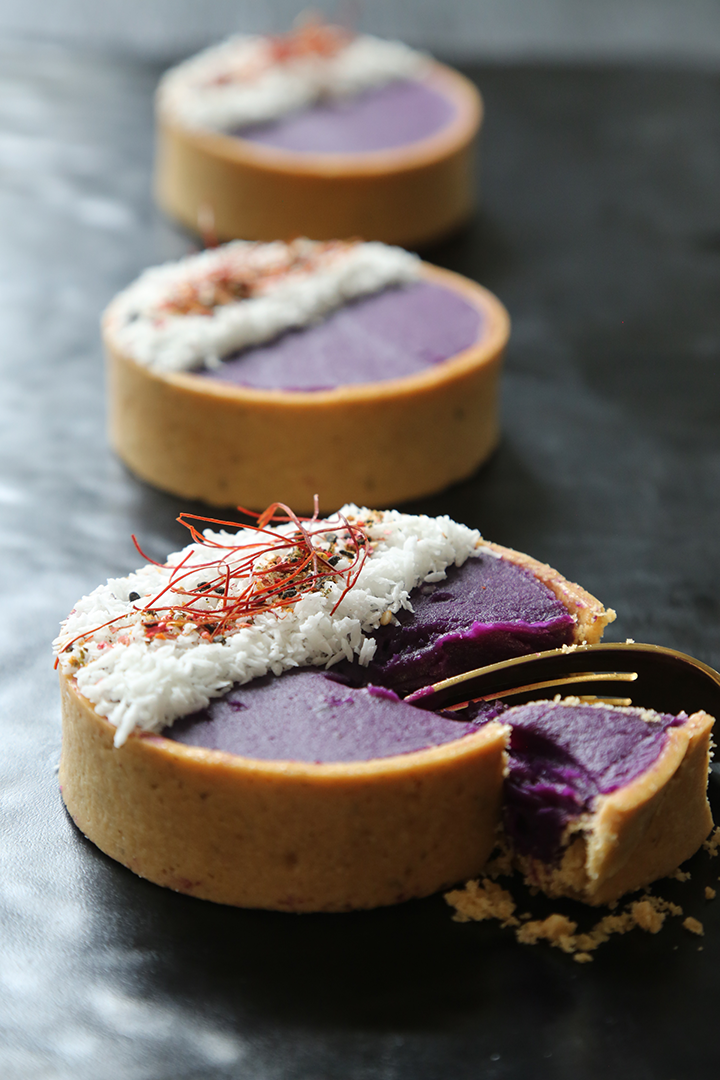
Ube Tarts
Recipe and photo courtesy Eatertainment Events & Catering
Ingredients
Method
- Preheat the oven to 350°F.
- In a mixing bowl, add all the ingredients and mix until well combined (use a hand-held mixer or stand mixer).
- Pour the ube filling into the tart shells and bake for 10-12 minutes.
- Remove from the oven and cool completely.
- Top with shredded coconut and saffron.



